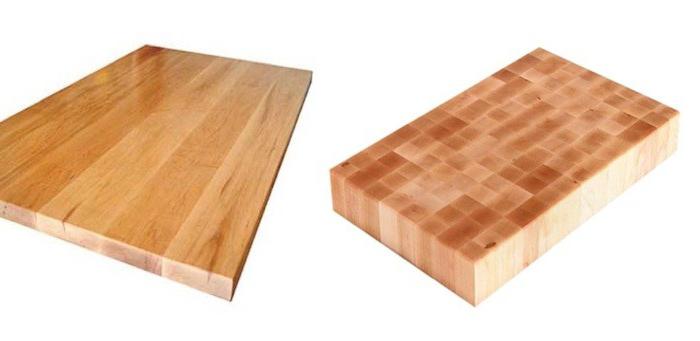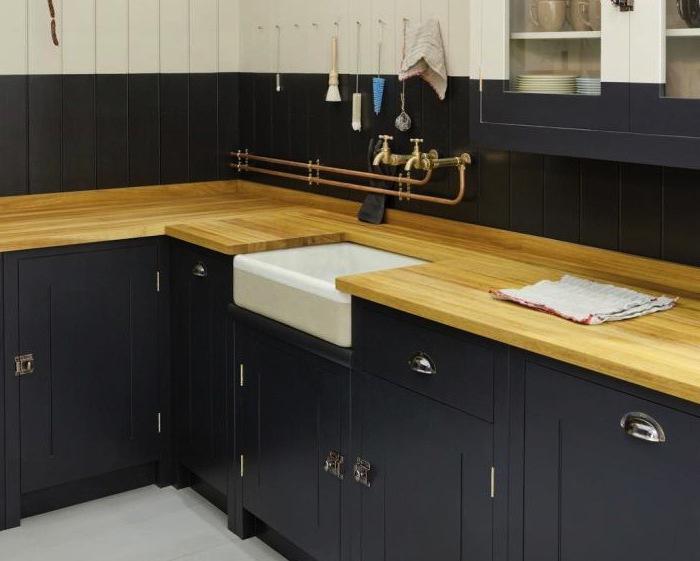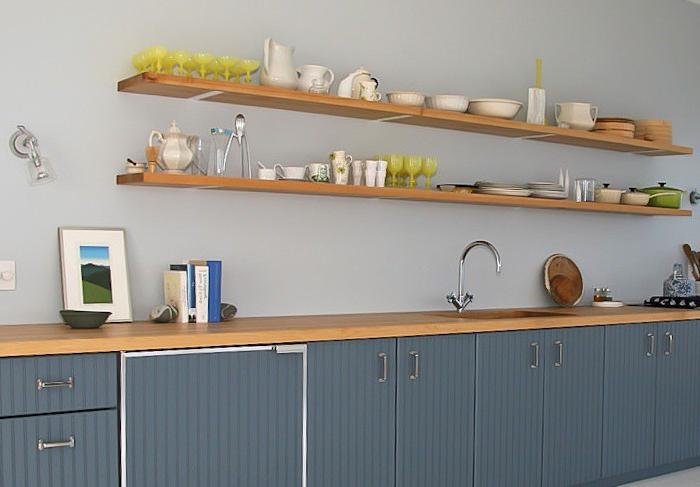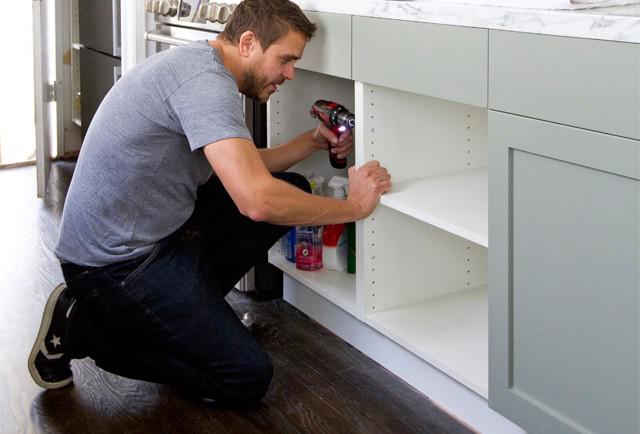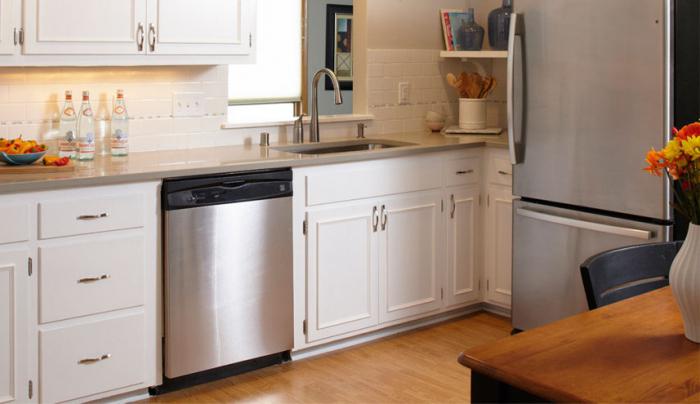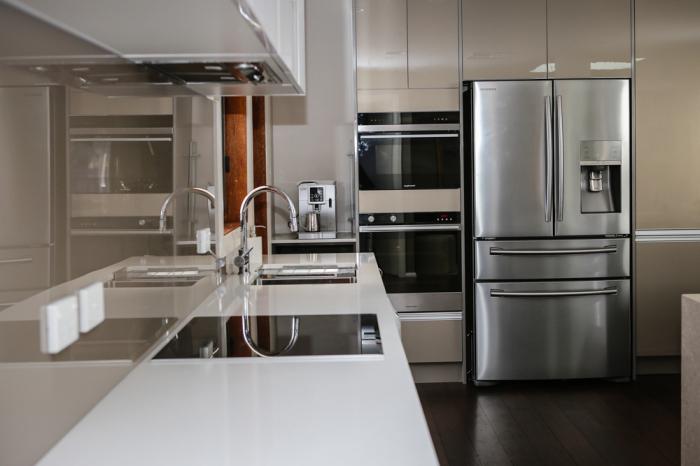Inexpensive kitchen renovation: how to do everything at the highest level. What repair is better to do in the kitchen: subtleties and secrets
It is quite possible to make repairs in the kitchen with your own hands! I was convinced of this myself, when my wife and I decided to freshen up our apartment with something on New Year's Eve 2012 ... Everyone prepares for this holiday in different ways, and we also decided to go beyond the classical framework of preparation. The task seemed impossible, since neither I nor my wife, before that, had ever encountered a full-fledged repair (by education and occupation, they are far from this), however, the desire to do everything on our own took up, and we still started repairs. I will say right away that everything ended very well: the work was fully completed 9 days after the start. In our case, it took about $260, the kitchen has become noticeably more beautiful, modern and cozy appearance.
All our actions can be divided into several stages, which together are a kind of plan, following which you can cope with the repair without any problems. It should be understood that each kitchen has its own characteristics, so our recommendations may be inaccurate in relation to your apartment.
1. Repair idea
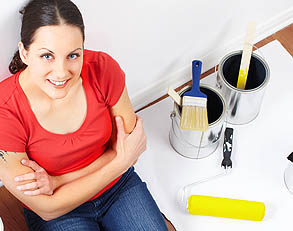 Start any repair work it is necessary precisely from the idea, that is, what do you want to ultimately achieve from the kitchen to a greater extent: coziness, comfort, modernity, functionality, etc. Make a list of what the kitchen lacks, for example, in our case, the main problem consisted in a small area (about 5 square meters). It was necessary to place on it: a refrigerator, a stove, a sink, dinner table and organize a place where the necessary utensils for cooking would be stored.
Start any repair work it is necessary precisely from the idea, that is, what do you want to ultimately achieve from the kitchen to a greater extent: coziness, comfort, modernity, functionality, etc. Make a list of what the kitchen lacks, for example, in our case, the main problem consisted in a small area (about 5 square meters). It was necessary to place on it: a refrigerator, a stove, a sink, dinner table and organize a place where the necessary utensils for cooking would be stored.
The right move would be individual order furniture for the kitchen, but in this case we lose a significant amount of the family budget. We're spending money on new furniture did not plan, as on the nose New Year and, it is necessary to purchase gifts, a table and other trifles, however, even without a new one, we managed to achieve our goal - we just spent more time in stores searching for the necessary building materials. Conclusion: if time is precious to you, give the idea of repairing the kitchen to specialists, if money plays much more important role, then an independent approach can also bear fruit.
2. Color range
When planning a kitchen, it is better to think in advance color scheme, which will be present in the interior. For the kitchen, green and orange shades are more suitable. Try not to use dark colors, since they reduce space and generally act depressingly on a person. We stopped at this point in more detail in the article: we recommend reading!
3. Walls and ceiling
We recommend continuing the repair process with, since when it is painted or wallpapered, all the dirt will remain on the walls and floor. Along working area it is necessary to place the so-called apron from, since these places are most often contaminated, and the tile allows you to wipe stains from it with any detergents.
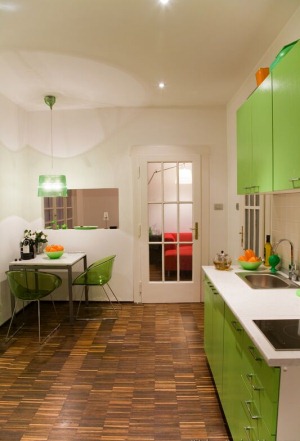 In our case, the apron has already been completed (a year ago we paid $ 100 for it, which included the payment for the work of the craftsmen and the cost of the tile itself). Therefore, it remained only to solve the problem with the walls and ceiling. Our family decided to give up on painting the walls, as painted walls are more practical (they are washable, and especially worn places can simply be painted over with the same color). And most importantly, the paint is easier to apply on the curved walls of the “Khrushchev”. However, painting requires perfectly flat surfaces, otherwise all the notches, cracks and bumps will significantly worsen the look of the kitchen. Putty will help get rid of irregularities.
In our case, the apron has already been completed (a year ago we paid $ 100 for it, which included the payment for the work of the craftsmen and the cost of the tile itself). Therefore, it remained only to solve the problem with the walls and ceiling. Our family decided to give up on painting the walls, as painted walls are more practical (they are washable, and especially worn places can simply be painted over with the same color). And most importantly, the paint is easier to apply on the curved walls of the “Khrushchev”. However, painting requires perfectly flat surfaces, otherwise all the notches, cracks and bumps will significantly worsen the look of the kitchen. Putty will help get rid of irregularities.
So, if you decide to paint and putty the walls, you will need the following instruments:
- putty knife;
- brush-brush - this is a wide brush for applying a primer;
- paint roller;
- paint tray for paint;
- sanding block and emery mesh (sandpaper);
- bucket (for kneading putty).
materials for painting and puttying the kitchen:
- interior paint for the ceiling and walls (it is better to take types of paints that can be washed or wet cleaned);
- finishing putty;
- primer.
Volume or quantity of materials:
- 1 liter of paint is enough for an area of 7-8 square meters;
- 1 kilogram of putty is enough for about 1 square meter;
- 1 liter of primer is enough for 10-15 square meters.
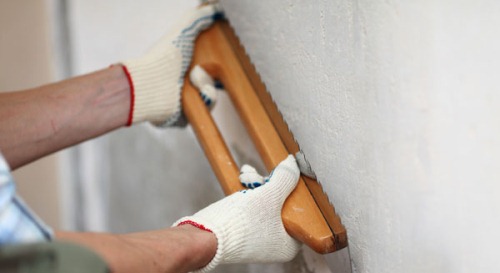
Now let's talk a little about the nuances:
- it is better not to save on paint for walls and ceilings. We took the paint of the TRIORA trade company 3 liters ~ it cost $ 35, because it dries quickly (1-2 hours), does not have a strong smell and is easy to lay down on the walls (i.e. without streaks);
- paint is better to take matte, velvet, which will hide minor wall defects;
- putty can be taken at least the cheapest. We tried all the putties available in the assortment of the construction salon of our city, there is no difference in them;
- I recommend using a universal primer. deep penetration in concentrate to dilute it with water (1 liter of water to 1 liter of primer), so you can save a little on the family budget.
How to paint the walls in the kitchen (you can read more about this topic in our next article):
- completely get rid of old wallpaper and paint on the ceiling and walls;
- apply a layer of primer and let it soak in for 4-12 hours;
- and the ceiling with finishing putty;
- let it dry completely (from 12 hours, depending on the thickness of the layer);
- sand the surface;
- if the surface still has irregularities (cracks, notches, bumps), apply another layer of putty, let it dry and sand again;
- apply a layer of primer on the dried wall and let it soak for 4 hours;
- paint the walls and ceiling.

Now let's clarify the ambiguities. Removal from walls and ceilings old paint and wallpaper is necessary in order to later new painting didn't fall behind. The primer evens out the absorbency, it is also necessary for high-quality adhesion of the treated surface with subsequent layers (with paint or putty). Finishing putty perfectly evens out the defects of walls and ceilings, however, it often requires several layers of application.
To prepare the putty, you need to dilute the dry mixture with water, in a ratio of approximately 800 grams of the mixture per 1 liter of water.
4. Gender
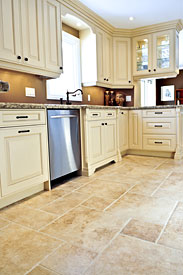 Ideally, the floor in the kitchen should be made of tiles, but it is quite difficult, since before that it is necessary to rip off the old floors, apply a cement screed, and then only lay out the tiles. Much easier to just lay linoleum. If the floor has significant cracks or other irregularities, it can be covered first. fiberboard sheets, nailing them, and lay linoleum on top. Don't forget to change the skirting boards as well, as they will noticeably add to the neatness of the appearance of the kitchen.
Ideally, the floor in the kitchen should be made of tiles, but it is quite difficult, since before that it is necessary to rip off the old floors, apply a cement screed, and then only lay out the tiles. Much easier to just lay linoleum. If the floor has significant cracks or other irregularities, it can be covered first. fiberboard sheets, nailing them, and lay linoleum on top. Don't forget to change the skirting boards as well, as they will noticeably add to the neatness of the appearance of the kitchen.
5. Aesthetic moments
The main thing is behind, now let's add some little things that will enliven your kitchen and give it freshness:
- change old lamp on new. Perfect for the kitchen hanging lamp with lampshade. Screw a standard pear-shaped frosted light bulb into the lamp, which will create a soft and diffused light in the kitchen;
- Get a new comfortable one, it will add coziness to the dining area;
- Hang in the color tone of the walls, they will also give freshness to the kitchen. Don't forget about the new cornice for curtains and tulle;
- If there is no money for new furniture, it can always be updated by painting, pasting self-adhesive film for furniture, changing handles and applying decorative patterns;
- and don't forget to do it right.
Finally, a few of our figures that will help you navigate your budget assessment:
- at 25 square meters walls and ceiling took 35 kilograms of putty;
- 3 liters of interior paint (in 2 layers) were used for 17 square meters of walls;
- 1.5 liters of interior paint were used for 8 square meters of the ceiling;
- 7.5 square meters needed linoleum (+ in our case, we captured part of the corridor);
- it took 4 strips of skirting boards and several external and internal corners, plugs, as well as 1 strip of butt-overlapping threshold.
In terms of money, our expenses were as follows:
- ~45 dollars paint;
- ~55 dollars linoleum;
- ~$17 plinth;
- ~10 dollars putty;
- ~4 dollars primer;
- ~$100 new dining table;
- ~$15 curtains and tulle;
- ~$2 cornice with clips for curtains;
- ~15 dollars lamp.
Saved over $200 in labor costs by doing the kitchen upgrades ourselves. The repair was delayed for 9 days, since they spent 2 to 4 hours a day on it. Our next step will be.

I hope now you understand that it is quite possible to carry out repairs in the kitchen on your own, the main thing is to have at least a little desire and diligence. I wish you success!!!
Take a look at the picture below. On the left - the kitchen in the "Khrushchev" (it is also the "Khrushchev refrigerator"), panel house the infamous 464 project. On the right is a refurbished one. To make such a kitchen repair with your own hands to a non-professional builder alone, with occasional little help from home, is quite possible. The total cost of work, starting from the removal of the old "junk" - about two monthly salaries, in installments as the work is carried out; the duration of the repair is 3.5 months, on weekends and evenings. Two times for an hour and a half in the kitchen, you will need to turn off the electricity, four times within 3-7 days you will have to cook food on an electric stove, and wash the dishes in the bathroom.
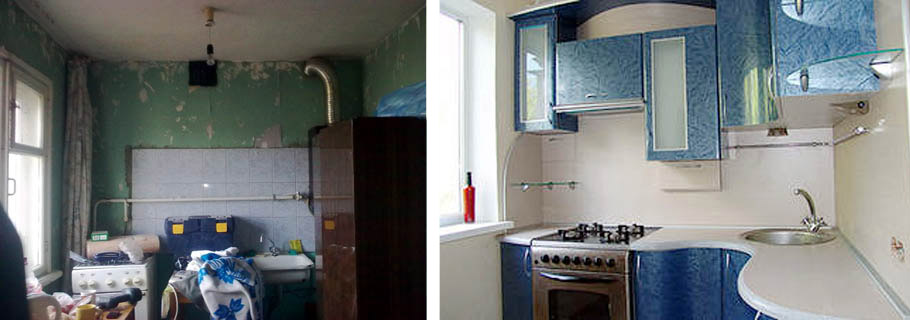
Photo: Kitchen in Khrushchev before and after repair
But before saying, like Gagarin: “Let's go!”, It will take another three months of reflection, meetings and disputes. The kitchen is a very difficult object to repair, and its modern repair, and even for a long time and inexpensively, should be thought out to the smallest detail. We will try to help our readers with this.
What are the difficulties?
When preparing a kitchen renovation, you must always remember the following features of the room:
- High humidity– evaporation from cooking and/or washing.
- Elevated temperature.
- The presence of powerful heat sources: Only the stove provides more than 10 kW of heat output.
- Aggressive atmosphere- when cooking, fat also evaporates, the products of its hydrolysis during frying, others volatiles from products.
- Sharp fluctuations of the above factors; for decoration and furniture, this “hit” is stronger than their consistently high values.
- Increased hygiene requirements: a raid of organic matter and its accumulation in the nooks and crannies creates favorable conditions for the reproduction of microorganisms, especially in warm, moist air.
- Availability gas appliances; special attention should be paid to ventilation.
- High room occupancy: The occupancy rate and habitability of the kitchen is higher than any other room.
- Small space and low ceiling , if this simple kitchen in a typical house.
- Constant indoor circulation fragile, breakable and dirty objects.
Stages of a long journey
How to start a kitchen renovation? What to do first, and what then? When to buy materials and how to allocate costs Money? We will briefly describe the stages, and then we will give explanations for each point.
- Measurement and revision of the condition of the premises;
- Development of equipment placement scheme;
- Development of design, furnishing plan and final choice furniture;
- Room cleaning;
- Cleaning of walls, ceiling, floor;
- Revision and repair of the base floor;
- Revision and basic repair of the ceiling;
- Re-laying of communications;
- Refinement of ventilation;
- Window and door replacement;
- Ceiling decoration;
- Wall decoration;
- flooring;
- Installation of skirting boards;
- Installation of equipment;
- Furnishings;
- A solemn banquet, if there are still forces left.
These works must be carried out in in full, possibly with unforeseen complications if the kitchen is being renovated in Khrushchev. In older or newer houses, some steps, especially on the ceiling and floor, will be easier. But still, kitchen renovation is the limit of complexity and laboriousness for home master, therefore, after reading the article, think carefully: is it possible? Isn't it better to tighten up financially and entrust this matter to professionals?
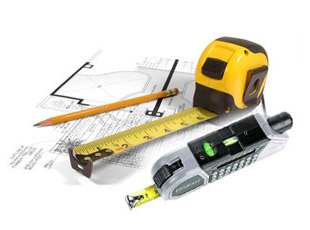
Measurement and revision
The following dimensions need to be removed:
- Length Width Height.
- Window and door - the dimensions of the OPENINGS and the distance from the walls, ceiling, floor (for windows).
- Mezzanine - size, location, material.
- Rosette groups (group) - distance from the floor and walls.
- Water supply and sewerage - the same.
- The gas station is the same.
- Ventilation outlet - the same, plus a revision of the ventilation device, see below.
- Cornices, stucco moldings, ledges of floor slabs, if any - the same.
The accuracy of measurements is no worse than 0.5 cm. Repair of a small kitchen must be done according to an exact plan, see below. Otherwise, the accumulating error may eventually give a door that does not close, or dishes that are constantly inadvertently swept away by an elbow on the floor, or some other unremovable inconvenience.
When inspecting the ventilation device, it is necessary to determine by external inspection and / or a thin flexible twig whether the building design provides for a separate ventilation duct for the kitchen. If the vent is on vertical box in the wall, then yes, and that's good. If the ventilation duct goes towards the bathroom and toilet, this is not very good, but fixable, see below.
Planning and project
As a result of the procedures described below, you should get a plan for the placement of furniture and equipment in the kitchen, see the picture:
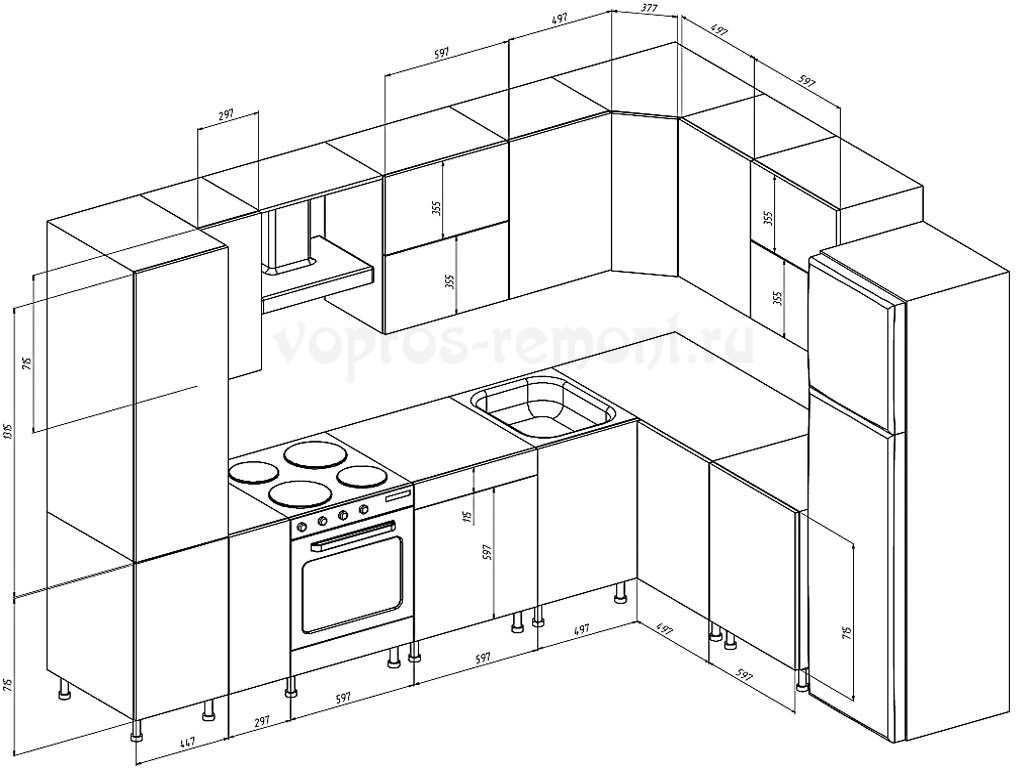
Traditional kitchen equipment plan
Furniture must be pre-selected in advance and its exact dimensions taken on site from the seller or taken from the catalog. In order not to draw and redraw on whatman paper or toil in 3D graphics or CAD systems, we recommend the following method:
- From cardboard, on a scale, we glue a box without a lid, cut a window and a door in the walls.
- We cut cubes and polyhedrons from polystyrene, also on a scale corresponding to furniture and equipment; we note where what is, with inscriptions or roughly draw front panels on the foam plastic with a marker.
- We play with cubes until we get an acceptable option. We stick the model to the walls of the box with pieces of plasticine or chewed gum.
- We simulate natural lighting with an LED flashlight. By moving it, you can display the course of the Sun in different time of the year. To simulate cloudy weather, we cover the aperture of the flashlight with a piece of thin paper.
- Upon receipt of a satisfactory layout according to the known dimensions of the models, we build a plan, on paper or a computer. In the latter case, it is enough to sit in CorelDraw for 2-3 hours, and the development of a 3D placement layout requires at least a day of work by an experienced designer.
The main principle of the kitchen layout is the triangle of functionality: stove, sink, refrigerator. Its sides should be approximately equal length, and no more than 6 feet (1.85 m) each.
The planning sequence is as follows:
- Communications;
- Equipment;
- Furniture.
Video: an example of a small kitchen project
Communications
Here the main problem is to remove the ugly gas descent from the riser along the wall. Fortunately, now it is allowed to connect gas appliances with flexible hoses, and gas workers, as soon as they show them at least a picture, most often meet halfway and issue a permit without delay - such are the fruits of constructivism of the era of the unforgettable Nikita Sergeevich, they themselves are a thorn in the eye and a headache.
A warning: Under no circumstances should you work on gas on your own! You need permission and a specialized team: you will have to cut and weld gas pipes!
When planning, you need to clearly remember: allowable length flexible gas hoses - 4 m; water and sewer - 1.5 m. Bending of rigid sewer pipes in the horizontal plane is unacceptable; corrugated bends - let's say a single one at least 120 degrees.
If you have a kitchen with a geyser, then “on the sly” it is highly desirable to immediately issue permission to transfer and replace it. You can specify any place, according to a preliminary plan; then they will not measure to the millimeter.
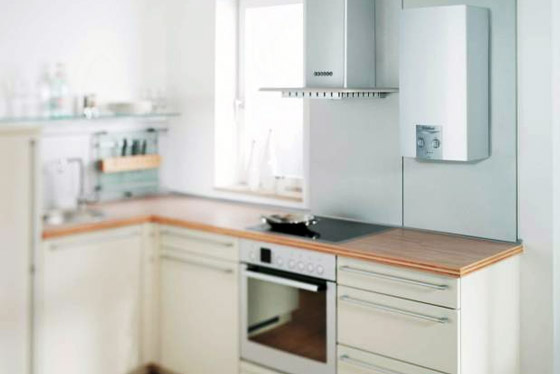
Gas hoses and pipes should be accessible for inspection, but this does not mean that they should show off in plain sight. It is perfectly acceptable to lay them behind furniture without back walls(doors opened and visible) or behind a washer on wheels, easily rolled out. Hoses behind a washer that is firmly on the floor can cause claims from the gas service.
In Khrushchev's kitchens, as a rule, initially there is only one outlet on the wall farthest from the stove. Of course, you also need a socket group above the cutting table, so when planning, you need to provide a separate wiring branch to it. It is also desirable instead of a regular dose (electric distribution box; there is always one in kitchens) for the kitchen as a whole, a washing machine and an electric boiler, if any. This will require turning off the electricity in the apartment twice for a short time; wiring for additional sockets is laid in the process of work on the walls and ceiling.
Equipment
Cooker, hood, ventilation
A cooker hood is a stumbling block when renovating a kitchen: it can disrupt the ventilation of both you and your neighbors. Hood with air recirculation and carbon filter not a way out: odors still seep through it, and a disposable and not very cheap filter needs to be changed periodically.
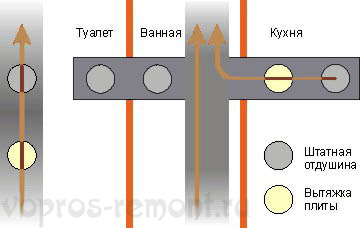
The output is a hood with a reusable (washable) grease aluminum filter and exhaust into the house ventilation. For it, you will need to break through an additional ventilation outlet. Actually, this is already a redevelopment, and permission is needed, but this is just the case when you can, if you are careful. The main thing is not to create a blower from the ventilation for anyone and to prevent clogging of the ventilation passage with construction waste.
If the kitchen has a separate ventilation duct, then the vent for the hood must be done BELOW the main one (on the right in the figure). In such passages, there is good traction, and blowing from a hood with a fan up to 65 W will only improve standard ventilation. We get rid of exhaust pipe(the lower the vent for the hood, the better) and free up space on the wall.
A warning: but remember - in no case should you start the exhaust gases of the hood and the gas boiler in one ventilation passage! Here you are no longer risking a fine and sanctions, but your life!
If the ventilation of the kitchen with a bathroom is connected to a common ventilation duct (this is in the same project 464, so that its creators have neither a bottom nor a tire), then the vent for the hood must be made FAR AROUND THE AIR CURRENT, and as far as possible, in the figure - on the right.
The next task is to break through a new vent cleanly, "without noise and dust." This is done as follows:

- In the center of the area to be cut down, we drill a hole through and drive a self-tapping screw into it in the dowel; fastener size - any. We do not turn the self-tapping screw all the way.
- We tie a twine to the protruding head of the self-tapping screw, and attach its other end higher to the ceiling or furniture.
- Along the contour of the future vent with a 4-6 mm stone drill, holes are drilled “to the piercing” through 5-10 mm. It is advisable to immediately drill the contour of the exhaust pipe according to the template.
- With a narrow chisel or a special chisel for cutting grooves - a cross cutter - we chop off the jumpers between the holes 1-1.5 cm deep.
- With a vacuum cleaner, always with a dust collector, we suck the groove.
- We repeat the procedure until the cut piece hangs on the twine; then we take it out - a clean vent is ready.
- How to install the hood further -.
Notes:
- You don’t have to buy a dust collector - from a 2-3 liter jar with a sealed lid, you get an excellent home-made one, see the picture above. Hoses - garden pvc internal diameter not less than 20 mm.
- It is easier and cleaner to cut with a crosscut than with a chisel or a regular chisel. The tool is specific, they do not offer it for rent, but it is inexpensive, and then it will come in handy on the farm.
Off topic note: curiously, but the described tricks are no longer known from construction, but from their criminal practice. The characters of the famous film “Va-bank” took out a piece of the wall cleanly, and with the help of a dust collector several decades ago, a large Amsterdam jewelry company was completely robbed. The accomplice inside had a hose pushed through the ventilation. There were completely legal, owner-driven window cleaners working on the façade, while a powerful industrial vacuum cleaner was working just as hard in their van.
Stove, boiler and refrigerator
According to the rules for the operation of gas appliances, they must be located no closer than 80 cm from each other, and in the case of a stove with a boiler, this requirement is not formal. It is also undesirable to move the refrigerator closer to the stove closer than 60 cm - from heating it from the side, electricity consumption increases significantly for the budget and the likelihood of breakage increases.
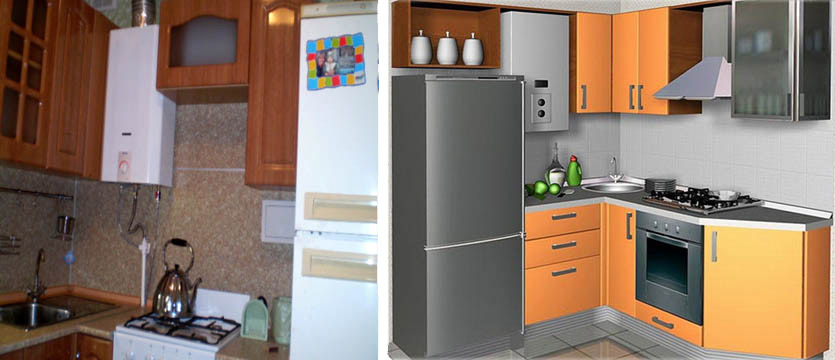
An example of an incorrect kitchen layout is given in the figure on the left, and a correct one, in compliance with the functionality triangle, is on the right. Refrigerator location near gas boiler it’s possible that it doesn’t heat up very much to the sides, but in general it is worth talking about the refrigerator in the kitchen.
Fridge
The refrigerator in the kitchen, as mentioned above, is hard. He's better the cooler it is outside. Therefore, the best option for placing a refrigerator in an apartment is on a glazed balcony or, if there is space, in the hallway. On the balcony, it’s generally wonderful: the electricity consumption of a refrigerator in summer decreases by 1.5-2 times, and in winter - 6-10 times. An exception - south balcony in warm climes. There, due to direct heating sunbeams In summer, the effect can be reversed.
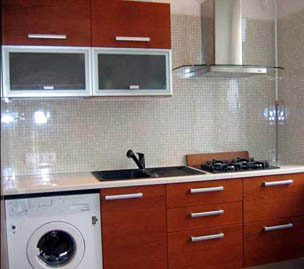
Washing machine in Khrushchev's kitchen
But roaming all the time back and forth for groceries is unlikely to please any hostess. The way out is a small single-chamber (without a freezer) refrigerator for a consumable supply of food. This is an expense of 3-5 thousand rubles. additionally, but in a winter or two it pays off.
In the Khrushchev kitchen, this frees up space for the washing machine in a completely natural way (see Fig.), And a small refrigerator can be placed on the table above it. Instead of one unit kitchen equipment- two on the same area, which is not in abundance in the kitchen.
A consumable refrigerator needs an absorption or semiconductor one, based on the Peltier effect. These do not make any noise at all, and the latter also do not require refueling with refrigerant. They freeze, however, worse, but for a consumable portion of products this is not essential.
Of the domestic models, “Morozko” was purposely created for such a purpose (on the left in the figure below). "Morozko" used almost like new can be bought for 1500-1700 rubles. Biryusa, Sansung and Shivaki (pictured in the center) have small freezers but are more expensive. It is undesirable to take the Ukrainian Nord: it costs only a little cheaper than the “company”, and breaks down much more often.

As for the Chinese-Swiss (it happens ...) Liberton'a LMR-128, in fig. on the right, it is better to bypass it by the tenth road:
- After a month or two, it starts to grumble and itch disgustingly.
- The freezer works on self-freezing, and not on freezing food.
- It is impossible to remove a boiled sausage or a piece of meat from the freezer: the upper protrusion of its lid works as a stopper.
- At the slightest frost when trying to open the freezer lid from a thin brittle plastic she breaks down.
- Animals that lay eggs that do not fall out of the corresponding Liberton trays are unknown to science.
- Six months later, the inner lining of low-quality PVC begins to crack.
In general, Europe and China turned out to be China for all Chinese.
Microwave
Microwave in a small kitchen is better to hang on the wall under the cabinet. The design of most microwaves provides for their suspension on the wall.
Electrical safety at work
Before starting construction work, the kitchen is completely de-energized by turning off the branch that feeds it at a dose near the meter or in the apartment panel. During operation, it will be necessary to illuminate and power the tool from an extension cord extended from another room.
If the kitchen is powered by one branch with a toilet and a bathroom (again, 464 project, be it wrong!), Then in the bathroom the segment to the kitchen is turned off: the wiring is probably aluminum in dried insulation, and it still needs to be changed. After that, the power supply of the bathroom is restored. This work, of course, is performed with a completely de-energized apartment.
Stages of repair and finishing works
Room cleaning
IN old kitchen the ceiling, walls and floor are saturated with fatty fumes up to the main wall, and a lot has also been absorbed into it. Therefore, cleaning the room includes three stages: peeling, washing and impregnation, otherwise there is no certainty that the finish will hold. But first of all, they remove the old flooring to the screed.
Peeling is done with preliminary soaking of the coating: paint and plaster are additionally cemented with a child, and you can’t take them just like that. Water-based coatings and plaster are soaked with water from a spray bottle:
- Spray liberally.
- withstand tight closed doors and windows of an hour or two.
- Quickly, until dry, remove the coating with a spatula or "stocking" - an abrasive mesh.
- If it dries before the end of the work, the procedure is repeated.
Oil and other paints are removed in the same way, but moistened with a sponge with a composition to remove it, and the surface is kept according to the instructions for it. Ripped off in parts: the composition, of course, is more expensive than water and there is no point in wasting it. Imported and domestic formulations are equally effective, but ours require longer exposure and are cheaper. Work to remove oil or alkyd paint is carried out in a respirator and protective gloves, in a wide-ventilated apartment, except for the kitchen.
On walls soaked with kitchen fumes, paint and plaster will either not adhere well, or then begin to peel off. Therefore, after stripping the walls, the floor and the ceiling must be washed with any dishwashing detergent diluted in water in a ratio of 1:20 by volume. Also, 5% table vinegar is added to the washing solution. First you need to check on a small portion whether the vinegar reacts with the detergent. Bubbles, seething, pungent odor - the components are incompatible, you need to take another detergent. Wash with a metal sponge with pressure, often dipping it into the solution. Then twice with a foam rubber sponge is washed with clean water.
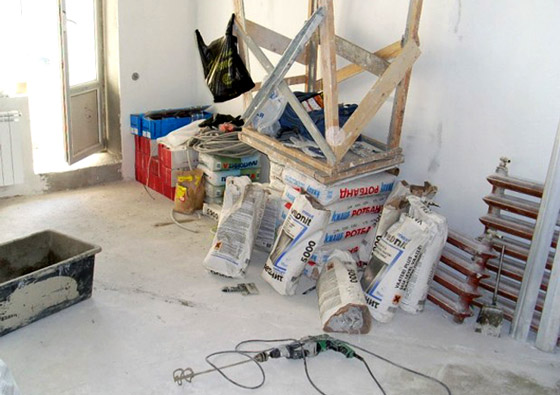
The final stage of cleaning the room is impregnation with a deep penetration primer on concrete. Soak twice a day. The primer must be with biocidal additives. When buying, we check the recipe on the label: thiuram and its derivatives (fernazone, arozone, thiram) are unacceptable. If the recipe is not specified, do not take.
Floor revision
The purpose of the operation is to reveal the following on the floor:
- gaping, more than 2 mm wide, cracks;
- cracks intersecting, especially in the center of the floor;
- cracks or a grid of cracks along the perimeter;
- depressions and protrusions more than 3 mm high (depth);
- deviation from horizontal is more than 3 mm/m, or more than 10 mm along the diagonal of the room.
In the presence of any of the first three factors, it is necessary to replace the screed. This is complex and laborious work. Small cracks close up by any of the known methods.
The floor is checked for evenness and horizontality with a bubble level of at least 1 m in length. With only minor imperfections perfect solution- , see below. If there are extensive holes or bumps, or the floor is skewed, it needs to be leveled, not only for the convenience of working on the flooring, but also so that the spill does not flow into the corners.
The optimal solution in this case is a cement-based self-leveling floor with a layer of 10 mm from the highest corner or mound. Such a leveler is not very expensive, the expense for a small kitchen is small, and you can lay a finishing floor directly on it. By the way, when pouring with cement leveler, small cracks can not be repaired.
Ceiling revision
The kitchen ceiling is her most painful place: it is there that all the children go first of all. On the top floor of a house with a flat bituminous roof dripping from the ceiling, and the kitchen is full of electrical appliances. Therefore, in addition to the floor, you need to revise the ceiling, and very carefully.
When revising the ceiling, first of all, rusts are released - the seams between the plates; In the kitchen, this is most often one. Then, the old electrical wiring is pulled out of the channel between the plates. Evenness and horizontality are checked with the same level, but a deviation of 20 mm diagonally is permissible here. When the plates are shifted vertically by 30 mm or more relative to each other (it happens in the same project), we do not do ceiling alignment: extra hard work, money, materials. The suspended ceiling will solve the problem, see below.
What needs to be done during the revision, especially on the top floor in a panel house, is to foam the channel between the plates better (in layers) with a gun with a narrow nose. This will not save you from getting stuck from above, but the drops will pass into the adjacent bathroom and toilet, where there are fewer electricians, and the floor screed is designed for abundant flooding. 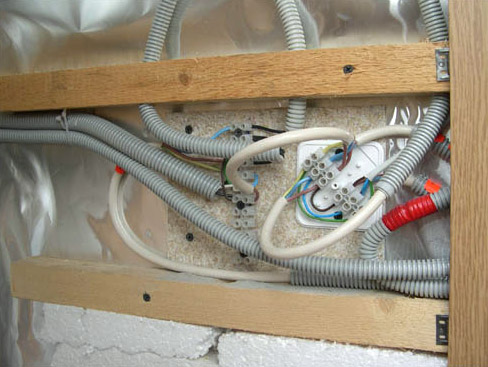
Laying communications
Gas, water, sewerage and ventilation are mentioned above. Let's add only the main thing about electricity.
If you plan to replace the dose with a shield, you need to hollow out a niche under it at a height of about 1.8 m so that children cannot reach the machines. It is inconvenient to put the shield in place of the dose: it is too high for adults to reach.
We lay the wiring with any flat three-wire cable in double insulation. Wires - rigid, single-core. Such a cable does not sag or sag weakly during laying. The cross section of the core is at least 1.4 square meters. mm (2 mm diameter).
In a dry room, it is advisable to lay the wiring in strobes and in a metal corrugated hose, but if there is a risk of jamming, it is better to lay it directly along the bare ceiling. Descents along plastered walls (if re-plastering is not provided) in any case will have to be pierced. We fix the cable after 10-15 cm with masking (paper) tape for a start; then in strobes - with strokes of gypsum or alabaster, and on bare surfaces with drops of building silicone.
Branches for lighting and sockets lead to the center of the ceiling. There, the lighting branch ends, and the rosettes go further, then turn to the walls at 90 degrees and descend along them to their own place each. We run the branches on the washer and the boiler along the wall 15-25 cm below the ceiling, wrap it down also at a right angle and bring it to the place.
To conduct wiring “as far as God puts it on your soul” is a common construction hack; the saved cable is allowed "to the left". This then greatly complicates troubleshooting and creates a risk to life during subsequent construction work. To deceive yourself is the last thing, and cable savings in a small kitchen are scanty.
If the apartment is not yet grounded, we leave the protective (yellow with a green stripe) conductors of the cable in a shield or dose, always insulated. When replacing the dose with a shield, it is better to immediately bring them into the appropriate terminals of the circuit breakers and RCDs.
Window and door
We change or restore the window and door, if required, upon completion of work on communications. You can do it, it's not important, but you need to make sure that the volatile residues from previous operations have weathered. To do this, we tightly close the room for a day, then we smell it. If the “spirit” is still felt, we ventilate more.
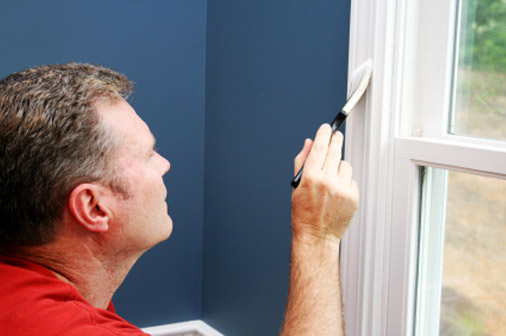
From dirty further work We protect the window and the door as usual: with a plastic film on masking tape.
Ceiling
The ceiling in the kitchen must meet the following requirements:
- To be resistant to sharp fluctuations in temperature and humidity.
- As little as possible and evenly fade, burn out and change tone under the influence of kitchen fumes.
- Do not let the fumes through you so that deposits of organic matter do not appear in the interceiling space - a tasty nutrient medium for microbes.
- Be brushable.
- To allow full or partial bulkheads and repairs without repairing the entire room.
- Have a design life of at least 10 years.
Based on this, foam and stretch ceiling, contrary to common recommendations, are unequivocally rejected: in the kitchen they serve no more than 5 years, when extracting with an ion or ultraviolet ionizer, and the relief on the foam plates begins to blacken and turn yellow after six months.
materials
Ceiling materials should be chosen as follows, in order of preference:
- Plastic lining or slats.
- Laminate impregnated from the inside with an aqueous PVA emulsion.
- MDF lining impregnated with it.
- Waterproof (green) gypsum board, rolled from the inside with a spiked roller and impregnated with PVA emulsion twice on both sides.
The length of the lining boards and MDF is 2.95 m. In most cases, this is enough to sew up the ceiling solid boards, but first you need to make a calculation of how best to sheathe, along or across, so that less material is required and less of it is wasted.
Sheathing and light
The crate for sheathing can be made linear, without crossbars, from metal profiles or wooden slats. Step of lags - 400-600 mm; the step of fastening the lags to the ceiling is 300-400 mm. In the dips under the slats or profiles of the crate with an uneven base ceiling, you can put pieces of plywood. Such a ceiling will not be ideally flat, but there will be no small irregularities on it, which spoil the view in oblique daylight.
During the installation of the crate, slots are made in it for the already laid electrical cable, if it is not in the strobes. The wiring for spotlights is done along the sheathing with a freely lying flexible cable with a cross section of 0.7 sq. mm.
Under spot light the interceiling space must be at least 80 mm. Under the plafond or chandelier in the center, 20x40 mm lathing slats, laid flat, are enough. The option of one main light is generally preferable, since it practically eliminates the penetration of organic vapors and their harmful consumers into the interceiling.
sheathing
Making the ceiling lining in the usual way: the panels are placed on a mounting adhesive and fixed with small studs in the corner of the groove of the tongue with a finisher (for) or self-tapping adhesives, for. In this case, when buying, you need to check that the crest of the tongue enters the reciprocal groove with the adhesive freely or without significant effort.
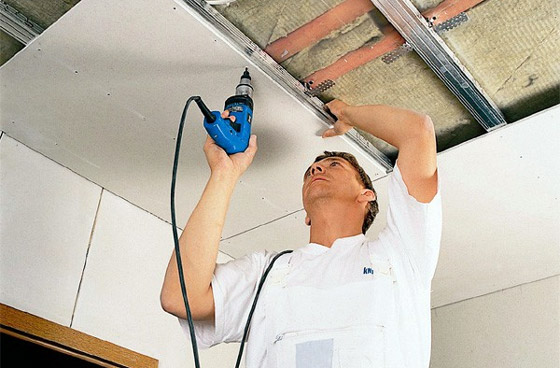
Plasterboard ceiling, but when paneling, a thin sausage is squeezed into the groove of each previous panel immediately before laying the next one silicone sealant; it will not let evaporation into the ceiling. Squeezed out streaks of silicone are immediately removed with a rag moistened with table vinegar. Before laying the last board, silicone is also squeezed into the groove of the finishing profile. When laying the last two boards together, "house" with pressure and snap, finish profile not needed, but this method requires certain skills and precise cutting of the last board to size in width.
When installing spotlights silicone is also applied to the edges of the holes under them around the perimeter.
Not recommended for the kitchen: no paint, even very expensive acrylic enamel for baths, will not last in the kitchen without changing the tone and the appearance of stains for more than 5-7 years. That is why drywall is ceiling material ranks last in order of preference; in addition, it is practically unrepairable separately.
Walls
The classic one is not as hygienic as it is commonly believed: the seams between the tiles become dirt accumulators. To avoid this, a bath or external composition is used for cutting joints with the addition of 10% by volume of a water-polymer emulsion recommended by the manufacturer. The cutting of the seams must be carried out either with a special trowel, or with a piece of a round electric cable in smooth PVC insulation with a diameter of 5-6 mm. When smoothing with a finger, even in a glove, micro-roughnesses will remain, which dirt with microbes are just waiting for.
The best option for wall decoration is plastic washable wallpaper. Foam, contrary to popular belief, does not accumulate odors. In this case it is necessary AFTER laying the floor, see below. By wrapping the wallpaper by 15-25 mm on the floor and ceiling, we will create an additional barrier to children and microbes in cozy nooks for them.
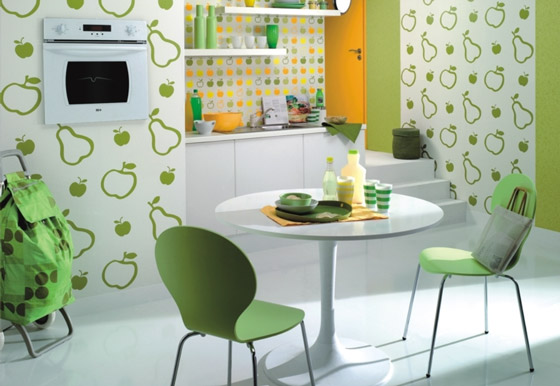
A good solution is lighter wallpaper in “clean” areas and more colorful (or darker) wallpaper in the area of \u200b\u200bthe stove in the cooking and dishwashing area.
It may seem like a paradox, but the durability of foam wallpapers in the kitchen depends more on their tone and pattern. Yellowish or light beige wallpaper with a small pattern pastel colors extra 2-3, or even 4-5 years will not remind you of the need for another repair compared to white or bright colors. All in all, properly selected foam wallpapers from elementary neat owners serve for 10-12 or more years.
flooring
The tiled floor for the kitchen, in addition to laboriousness, is also bad for its rigidity: dropped dishes will certainly break. parquet, cork, wooden planks flammable, microbes are well bred in them. The cork, in addition, swells from the spilled one.
The best material for a decorative floor in the kitchen is marmoleum:
- Marmoleum can be laid on an unprepared surface: it will cover small irregularities on the wrong side, and they will also play the role of anchors, so that the floating floor will hold firmly in place without any additional fixing measures.
- Marmoleum is dynamically elastic: withstanding a great constant pressure from furniture, it wins back when a dropped plate or cup hits, which in most cases saves them from death.
- Marmoleum has bactericidal properties that last for decades, but is harmless to humans and warm-blooded animals.
- Marmoleum is practically incombustible: a dropped cigarette burns to the end on it, and it remains as it was.
- Marmoleum can be washed with anything and in any way.
- Marmoleum wears out very badly: in the halls public buildings with a crowd of visitors, it serves for 10 years or more.
- Marmoleum is produced both in tiles and in rolls up to 6 m wide: cut off when buying to the specified size, brought, laid - the floor is ready.
In general, it is cheap compared to other options, and cheerful. The only “but” is that marmoleum, which accurately imitates the texture of wood, is not produced.
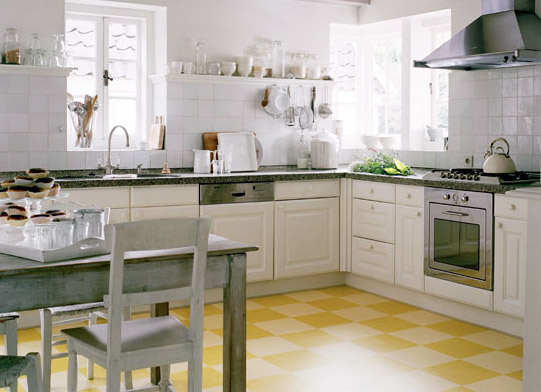
While not too popular among Russians, marmoleum is great for the kitchen in all respects.
Another acceptable flooring is over a self-leveling leveler. It is undesirable to make the floor on the logs in the kitchen for the sake of sanitation with hygiene, and with 6 m of the original boards, you can lay the floor without intermediate transverse seams. But a laminate floating floor around the perimeter will have to be wedged in pairs of wedges, and from time to time they may need to be padded, for which you will have to remove the baseboard.
Skirting boards
The purpose of skirting boards in the kitchen is not only decorative. They must also isolate the grooves around the perimeter from fumes, and therefore they are installed last, on liquid nails or silicone glue with continuous lubrication of mating surfaces. Silicone streaks are immediately removed with a rag with table vinegar, and assembly glue - with a solvent according to the instructions for the glue.
Ceiling plinth, whether you like it or not, you will have to additionally reinforce it with small carnations on laminate or MDF or self-tapping screws up to 3 mm in other cases. Self-tapping screws must be taken phosphated, black; shiny ones are too noticeable. The fastening step is 400-700 mm, so that the extreme ones fall 10-12 cm from the corners. From below, the hardware, most likely, will not be noticeable; if it is still visible, you need to miss liquid nails suitable tone.
It is enough to put the bottom plinth on marmoleum or laminate on glue; when viewed from above, the heads of the screws are clearly visible. If, nevertheless, there is a desire to plant tightly, the fastener heads must be drowned in the holes and covered with liquid nails. Painting baseboards, like everything in the kitchen, is undesirable.
Video: an example of do-it-yourself kitchen renovation
Outcome
So, now you have an idea how to make repairs in the kitchen. We emphasize - so far only a presentation. Each type of work has its own subtleties and requires another separate detailed description, which can be easily found on the pages of the site.
If you still decide on such a construction feat - self repair kitchen - good luck and patience!
Good afternoon, dear readers of the portal site. In this article, I share my experience cosmetic repairs in the kitchen with your own hands within five days. He performed all the work without assistants, the process took five part-time working days. The work was carried out in stages and included: preparation of the premises, elimination of wall and ceiling defects, restoration of the kitchen apron, painting work, replacement of linoleum and wallpaper.
The dimensions of our kitchen are 4.15*2.15m with a ceiling height of 2.5m. Before starting the repair, I estimated the scope of work and made a list necessary materials. It included:
- - floor screed - 25kg;
- - fiberboard 130 * 170cm - 5 sheets;
- - linoleum 2.5 * 4.5m;
- - floor plinth - 10m;
- - vinyl wallpaper 1.6 m wide - 3 rolls;
- - wallpaper glue - 1 pack;
- - glue for tiles - 1kg;
- - grout for joints - 2 kg;
- – washable acrylic paint – 3l;
- - wooden moldings - 10m;
- - self-tapping screws, HPS, nails.
The quantity and cost of materials is an individual matter and depends on the tasks assigned to you.
An important factor in the repair work is the presence necessary tool. I needed:
- - perforator;
- - nozzle on the perforator - whisk;
- - brushes and rollers for painting;
- - rubber roller for wallpaper;
- - spatulas: metal, rubber, spatula-comb.
Preparatory work
The first day.
Before starting work, it is necessary to clear the room of furniture and equipment, remove the box from the battery (if any). Ideally, work should be started in a completely empty kitchen, but in my case, it was decided to leave the hanging cabinets in place, because. replacing the wallpaper behind them was not included in the plans.
The next step is to clean the walls from the remnants of old wallpaper. You can use special means to remove wallpaper or just wet hard-to-grip pieces warm water like I did. The most important thing is to have time to scrape off the wallpaper before it dries. I used a spatula to speed up the process.
The apron was not subject to replacement this time, but clearly needed restoration. I carefully collected the fallen tiles and removed the tiles, the strength of which was in doubt.
He collected all the garbage in bags and proceeded to dismantle the floor covering. Skirting boards and linoleum were no longer good for anything and were sent to the scrap, but I carefully removed the fiberboard, which acted as a substrate, and left it to wait in the wings. The preparatory work was over and you can admire the results of the first day of repair.
Second day
I’ll make a reservation right away that I didn’t plan to level the walls and floor as part of a cosmetic renovation of the kitchen. But dismantling works discovered misfortunes that I could not close my eyes to.
Condition of the kitchen floor at the time of renovation
The holes in the walls were plastered (I used plaster and a wide trowel).
- Holes and obvious irregularities in the floor are eliminated with a cement screed. I used the cheapest one.
- Prepared solution: water and cement strainer, 1:4 approximately. I mixed it well with a construction mixer (in my case it was a perforator with a special nozzle).
- Wet the floor with water for better adhesion.
- Sufficiently sharp movements applied the solution to problem areas.
- Carefully leveled the mass with a spatula.
Restoration of a kitchen apron
Day two and three.
Let me remind you that after preparatory phase the apron looked like this:
The restoration process included the restoration of the missing elements of the apron and the grouting of all seams.
First of all, I primed the walls in the places where the missing tiles were attached. I note that the primer dries within 30 minutes. At this time, I prepared glue for tiles (the solution of the mixture with water to the consistency of thick sour cream was thoroughly mixed with a mixer).
- glue is applied to each tile with a spatula with a layer of about 5 mm;
- excess glue is removed with a spatula-comb;
- the tile is applied to the wall and slightly pressed;
- the position of the tile is adjusted according to the level, while maintaining the uniformity of the seams and edges.
Before grouting, there should be enough time for the tile adhesive to dry completely - at least a day (instructions to help). Grouting technology is also nothing complicated:
- on the rubber spatula we collect a small amount of mixture for grouting;
- press it into the seam, holding the spatula slightly at an angle;
- remove excess.
The main thing in this business is not to linger, as the grout mixture dries quickly. For the same reason, I advise you to knead the mixture in separate small portions per square meter.
After grouting, the old apron takes on an elegant look.
Painting works
Day three
Front painting works in our kitchen consisted of painting the ceiling, window opening, a long shelf under the ceiling, doors and moldings on the wall. I used super white washable acrylic paint. Painted with a roller and brushes different widths- wherever convenient. Used to protect glass on doors and windows. masking tape, hanging cabinets covered with polyethylene. To satisfy the result, I had enough painting in two layers.
Wooden moldings laid out on cardboard front side up and painted with a brush.
While the paint was drying between the layers, I prepared the walls for the upcoming wallpapering - I primed them with the cheapest wallpaper glue.
Linoleum laying
Day three.
Traditionally, laying flooring work is left to final stage repair. But our kitchen is distinguished by the intricate geometry of the walls (many protrusions and corners) and the abundance of pipes going into the floor. In order to avoid damage to new wallpaper in the process of cutting linoleum, it was decided to break the classic sequence of actions.
To begin with, I covered the floor with fiberboard sheets. As the first layer, I used sheets removed during the dismantling of the old floor, and laid the second layer freshly purchased wood slab. I fixed it all with self-tapping screws (3.5 / 42mm). Laying fiberboard in two layers made it possible to achieve an even coating.
The area of a piece of linoleum slightly exceeded the floor area. For cutting out right size I:
- Unfolded linoleum.
- Aligned a piece on a long wall without protrusions.
- Trimmed the linoleum under the doorway.
- Gradually cut the linoleum under all the pipes and ledges.
As a result, the linoleum lay flat, without going over the walls, repeating the perimeter of the room.
Wallpapering
Day four
We designed the walls in the kitchen vinyl wallpaper non-woven base. When gluing wallpaper of this type, special glue is applied with a roller only on the wall. To the wall generously smeared with glue, strictly vertically (for the first strip, a line can be drawn on the wall along the level), a prepared strip is applied and rolled out well with a rubber roller. If necessary, excess glue can be removed with a dry soft cloth.
The design of our updated kitchen involved wallpapering in two levels - a light top and a dark blue bottom. When gluing wallpaper in this way, it is better to start from the top.
To begin with, I carved required amount stripes light wallpaper 1.5m long. I glued them in the above way, starting from the window.
I cut the dark wallpaper into strips 1 m long and carefully glued it end-to-end to the top wallpaper. Mounting floor plinths and wall moldings.
Day five
At the junction of the wallpaper strictly horizontally (according to the level), I placed the previously painted wooden moldings and fixed them with nails 6 cm long (liquid nails can be used if desired).
Tip: if there is any doubt that the floor in your apartment is laid strictly horizontally, then in this case it is better not to use the level. Draw a horizontal line for the location of moldings in different places measuring the height of 1m from the floor. This is done because the furniture will stand on the floor and located on the wall. horizontal elements visually may appear unevenly nailed.
Floor plinths were mounted using the following technology:
- Attached the skirting board to the wall.
- A puncher drilled holes in the wall directly through the cable channel.
- HPS was driven into the holes obtained.
- I screwed the plinth with self-tapping screws with a press washer.
After that, he returned the furniture to its place and kitchen utensils. Plugged in the sink and gas stove. The kitchen is ready to use. Your comments?
How to make repairs in the kitchen with your own hands, if you don’t even know where to start? It's pretty frequently asked question, because today the materials themselves are not cheap, so not everyone can afford to pay extra for the services of masters.
And why, after all, to do good repair you can do it yourself, without resorting to the services of specialists. To do this, you need to clearly know what kind of cuisine you want to get in the end and move towards your goal according to a pre-planned plan.
Repair stages
So, let's look at how to make repairs in the kitchen with our own efforts. Divide your actions into several stages for the convenience of work. This is what any renovation needs.
Repair idea
Before starting any repair, you should understand what exactly you want to achieve:
- modernity,
- comfort,
- comfort,
- functionality
- or all together.
To do this, make a list of items that are missing in the kitchen commensurate with the dimensions of the room. If the kitchen area is small, then the surest step is to make custom-made furniture. This way you can "squeeze" whatever you want into the limited space.
But since the complete change kitchen set cost a pretty penny, then not everyone decides to change anything from furniture during repairs. Therefore, if you decide to do only the room, then immediately proceed to the next step.
Color spectrum
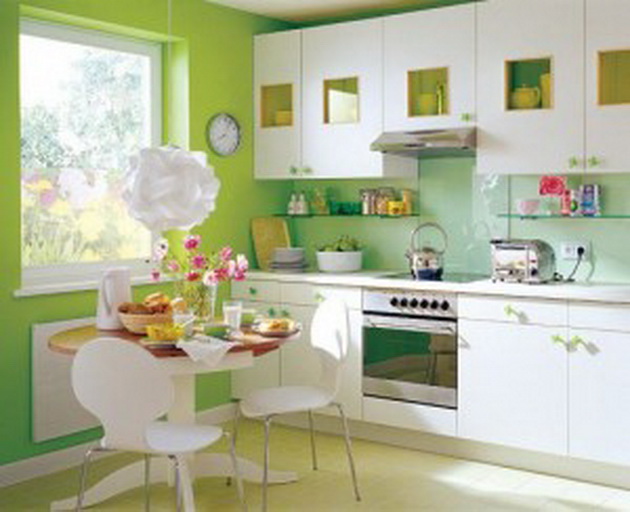
If the question is how to quickly make repairs in the kitchen, then you need to pay attention to several aspects. And the first one is color. When planning a renovation, it is better to think over the color scheme for the kitchen in advance. However, some people solve such issues already directly on the trading floor of the store, choosing from real options.
Advice! Do not use dark tones in the kitchen, as they reduce the space and act depressingly.
Walls and ceiling
We turn to the question: “how to make repairs in the kitchen?”. You should start from the ceiling, because when pasting it with wallpaper or painting it is very easy to stain the walls. It is recommended to place an apron made of ceramic tiles along the working area, since dampness and pollution are most often present in these places. The tile is the most convenient covering in leaving.

Next, you should decide what the walls will be covered with. Most best options is wallpapering or painting. Nowadays, the latter option is becoming more common, since such walls are more practical.
At the same time, the price of good paint is less than the cost quality wallpapers. And since the wallpapering procedure does not require instructions, we will stop at the staining option.
The application of paint should be carried out on an ideal flat surfaces. Otherwise, all the recesses, bumps and cracks will become very visible, which will significantly worsen the appearance of the kitchen. To combat irregularities, use putty.
In this case, you will need the following tools:
- Putty knife;
- Brush intended for applying a primer (maklovitsa);
- Paint tray for paint;
- roller;
- Emery skin;
- Bar for grinding;
- Bucket.
Materials needed for work:
- Primer;
- Interior paint designed for walls and ceilings.
Advice! Choose the types of paints that are intended for wet cleaning or sinks.

The nuances of work:
- It is advisable not to save on paint for the ceiling and walls. More expensive materials do not have a pungent odor, lie flat on the walls without leaving streaks and are characterized by fast drying.
- Buy matte, velvet paint that can hide minor wall defects.
- Putty can buy even the cheapest. There is no difference in them, so you can save money here.
- It is desirable to purchase a primer of deep penetration universal in concentrate so that it can be diluted with water (a liter of primer per liter of water). This is done to save money.
Since the question is: how to beautiful renovation on the kitchen?" largely depends on the coating of the walls, then this stage should be approached with special care. The order of work in this case will be as follows:
- Remove old wallpaper and paint from walls and ceilings.
- Apply primer. It should be absorbed within 4-12 hours depending on the manufacturer (read the recommendations on the package).
- Apply a layer of finishing putty to the walls and ceiling.
- Let the putty dry completely. Drying takes at least 12 hours. It all depends on the thickness of the applied layer.
- Sand the surface.
- In the event that irregularities (tubercles, cracks, recesses) remain on the surface, then you should apply another layer of putty. Let it dry again and sand it.
- Apply the primer to the dry wall, allowing it to soak in for 4 hours.
- Paint the walls and ceiling as shown in the photo below.

Since many people plan to do a kitchen renovation with their own hands, without having any skills, some explanations should be made here. Removing old paint and wallpaper from walls and ceilings is a necessary measure so that the applied paint does not lag behind after a while. Such work should be carried out with all care, because in this way you form the basis for future coverage.
By means of a primer, the surface is leveled. In addition, it is applied to ensure good adhesion of the paint to the surface. Finishing putty is used to even out all the defects of ceilings and walls. In most cases, it requires application in several layers.
Floor
How to make a floor in the kitchen: installation tips floor coverings» href="http://jkuhnya.ru/poll/509-kak-sdelat-pol-na-kuhne">How to make a floor in the kitchen? Ideally, kitchen floors are made of tiles. But laying tiles on the floor on your own is quite difficult task. And if the question is how to do inexpensive repair in the kitchen, then this option must be immediately cut off.
Conclusion
Naturally, only you can decide what repairs to make in the kitchen. Modern materials allow you to realize any design ideas. We considered the simplest and not expensive option renovation, through which you can get a stylish and modern kitchen.
You can, for example, install a multi-tiered ceiling structure from plasterboard with built-in lights or give preference to stretch ceilings.
Everyone, without exception, sooner or later faces the need for repairs. True, everyone’s reaction to it is different: some perceive this stage with horror, others are more calm, entrusting repair work to specialists, others are generally afraid to start it, since it is generally believed that this pleasure is not cheap, and the process itself is laborious and heavy. But if you competently approach the solution of this issue, then practically anyone can do a kitchen renovation inexpensively with their own hands. You just need to have the desire and be patient.
Today there are a lot building materials, which have properties such that correct selection and strict observance of the technologies of use will allow you to make repairs in the kitchen with your own hands not only good, but also of high quality. Modern building materials are easy to process, so we boldly purchase them and the necessary tools, after which you can begin to transform the room yourself. In this article, we will give you some recommendations and tips on how to properly do your own kitchen renovation.
How to start a kitchen renovation
Many people today strive (some - in order to save money, some - because of the desire to test their strength) to do the renovation of the apartment with their own hands. The kitchen is a special room, it is in it that reign:
- high humidity;
- oily spots;
- soot and other contaminants.
Kitchen renovation is much harder to carry out than any other room in the apartment in the sense that you will have to face the need to mount household appliances, equip communications, properly install kitchen furniture, it is convenient to place plumbing, repair the faucet in the kitchen with your own hands or completely replace it. And all this needs to be properly arranged and located in a small area. On our own to do all this front of work is difficult, but possible. All you need for this is to take into account all the nuances and subtleties of the choice of building materials, choose or come up with a finish option and know in detail the sequence of repair work, study their features.
![]()
The preparatory stage of the repair
Getting started, you need to clearly establish the sequence of the task. So, ahead - do-it-yourself kitchen renovation. Where to begin? Let's start with the choice of materials for the kitchen - this is an important and crucial stage, since the quality of the repair, the durability, and the time that will have to be spent on finishing depend on it.
Gender: what is the best material to use
As practice shows, the best materials for the floor in kitchen areas are considered:
- Ceramic tiles. Moisture resistant, has good performance on physical exercise, immune to various pollution. Modern ceramic tile has such a variety in design that allows you to embody the most different ideas ranging from imitation of old wood flooring to metal or marble. Among the shortcomings, it is worth highlighting the low thermal insulation and the complexity of laying.
- Linoleum. The most demanded and popular material. Installation is very easy and fast. As for the pricing policy, it is the most affordable of all existing floor coverings. Durable, immune to liquids spilled on its surface. Warm thanks to the lining. The only drawback is that it can be damaged by sharp objects: pierce or cut.
- Cork. The most pleasant coating for the feet. Environmentally friendly, heat-intensive. Especially useful for people with spinal diseases. Does not absorb water and kitchen fumes upper layer consists of varnish and special impregnation.
- Laminate. Easy to install and quite durable material. But in operation it requires some care in handling, for example, it is able to absorb liquids spilled on it, and if the liquid gets on the joint of the panels, then there is a risk of their swelling.
In this room, the walls are very exposed various pollution. When making repairs in the kitchen with your own hands, the material must be used one that can be easily washed:
- Washable wallpaper. Very well suited for kitchens, they look harmonious, easy to clean, practical, easy to glue. Alternatively, paintable non-woven wallpaper can also be used. Advantages in using wallpaper: the ability to create different patterns, colors in the design of the kitchen, hide small roughness and surface defects of the walls. The disadvantage is the instability to mechanical damage.
- Wall painting. This finishing method is considered inexpensive and very simple for walls. Professionals advise using matte paint - it will visually hide the main flaws on the walls. A feature of this method is the ability to repaint them at any time, changing the color to the desired one. The downside is it gets dirty quickly.
- Decorative plaster. Has a lot of textures to help hide the bumps. Using this material, you have the opportunity to create unique drawings or entire compositions on the walls. Absolutely safe for health, easy to care for, easy to clean, colorful complements any interior. The disadvantage is the difficulty in dismantling during subsequent repairs.
- Ceramic tile. As a rule, only kitchen apron, and the rest of the wall is finished with one of the materials described above.
Ceilings in the kitchen: what they are made of
There are not so many materials that are used to finish the ceiling, doing repairs in the kitchen with your own hands:
- Suspended ceiling. The basis of this material is plastic panels or moisture-resistant drywall. Plastic in this case stands out a little for its advantages: it is very easy to wash, it does not absorb fat deposits, stains and dirt. Drywall as a base is also good, you can create multi-level structures from it, but it needs to be periodically updated with whitewashing or painting. The disadvantage of a suspended ceiling is that during installation it takes about 10 cm from the height of the ceilings. This is very noticeable in kitchens with low ceilings.
- Stretch. This approach is unique in its quality characteristics. Typically used in kitchens glossy canvases from PVC film. They look very colorful, in case of flooding they are able to withstand up to 100 liters of water on their surface. Able to visually enlarge the space. The disadvantage is that they can be easily damaged by a heat gun).
- Ceiling tiles. This is the most cheap way ceiling finishes, the material is very easy to stick to the surface. Well hides flaws and irregularities. If necessary, any tile can be easily replaced if damaged. It is better to choose laminated - it is easy to wash, it does not absorb dirt and dust. Disadvantage - instability to high temperatures(melts), requires constant care.
Start of repair work: determine the sequence
We figured out the materials and their properties, then according to the plan - the sequence of repair work. It must be adhered to in order to achieve maximum results. Step-by-step instruction looks like this in 5 steps:
- Freed up as much as possible kitchen space from furniture, old communications that need to be replaced. You also need to check the suitability of the wiring.
- Draft repairs are being carried out: leveling the surfaces of the walls and ceiling and floor.
- If there is a need - change windows, window sills, doors.
- New communications are being installed.
- The ceiling surface is mounted or finished, then the walls, and lastly the floor.
Black finish. What does it consist of
This stage of repair includes:
- Wiring of pipes for water supply, sewerage, installation of a water meter, connection heating system. At this stage, doing a kitchen renovation with your own hands (in Khrushchev or apartments of the secondary old housing stock), it is possible and even desirable to get rid of metal pipes replacing them with plastic ones. They don't clog and are very easy to install.
- Replacing old, unusable electrical wiring. At this stage, consider the number of switches, sockets, fixtures and anything that requires power.
- The ceiling is being installed: a frame or a multi-level structure.
- The walls are leveled with plaster.
- If your floor is made of concrete, it must be perfect alignment. If necessary, a screed is made. The floor of the boards is strengthened or replaced. For insulation, wooden floors can be covered with fiberboard sheets on top.
Installation of windows and door structures
Before proceeding to finishing, if necessary, you can change the windows and doors. window structures are selected according to your desire: plastic models or modern wooden ones. Do-it-yourself installation is a very difficult and responsible stage. If you do not have special skills and are not a master, then it is better to leave it to professionals.
Doors for the kitchen can be of any design, material, shape, color. Or you can remove them altogether - it depends on what kind of design and do-it-yourself kitchen renovation you have planned. Can be installed instead of a door beautiful arch. This is very appropriate if you are doing a 6-meter kitchen renovation with your own hands and want to increase its space by connecting it to the living room.
Do-it-yourself kitchen exterior decoration
This is the final stage of the renovation.
- It starts from the ceilings - the material that you prefer is attached to the frame.
- The walls are primed, painted, wallpapered or finished with decorative plaster.
- The kitchen apron is off.
- At the end, the floor covering is laid.
- Installation work on the installation of sinks, hoods, sockets, switches.
- They repair the faucet in the kitchen with their own hands, if the repair is simple and feasible. Otherwise, it would be better to buy a new one.
Clean repair work
The main repair work has been left behind. Now we only have to install skirting boards on the floor, baguettes on the window (if any are planned), hang curtains, curtains, arrange furniture, household appliances.
The overall image of the kitchen is the style of this room. And in order to finish it taking into account aesthetics, you need to correctly combine:
- Furniture items.
- Decoration of walls, ceiling and floor.
- Textile.
- Other decorative items.
The project of a small but cozy and comfortable kitchen
The lack of square meters is a constant problem for many citizens living in high-rise buildings. Therefore, to implement a do-it-yourself kitchen renovation (6 square meters) and create its design in such a way that every centimeter of space is used to good use is the main task. positive side such repairs are considered small cash costs for building materials with a properly drawn up project.
Very important! Even before the startits implementation is necessarythink it over possible options down to furniture placement.
If you have a small kitchen, do-it-yourself repairs (9 meters or 6 with a total area - it doesn’t matter) must be carried out following the basic concept: try to visually expand the space. That is why you need to remember:
- Large and bulky objects and elements make the room visually smaller.
- The color scheme for small kitchens should be light. Such shades can visually add space and freedom.
- For small rooms, mirrored surfaces are the best suited: the light that is reflected in them makes the area visually larger.
Summing up
As you can see, it is possible to make repairs in the kitchen with your own hands. Furthermore, this process will save a lot of money, and the room itself will become the subject of your pride. The main thing is to stick to the sequence, buy quality materials and don't break technology.

